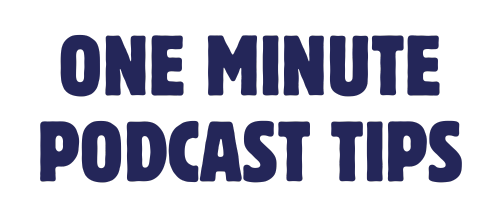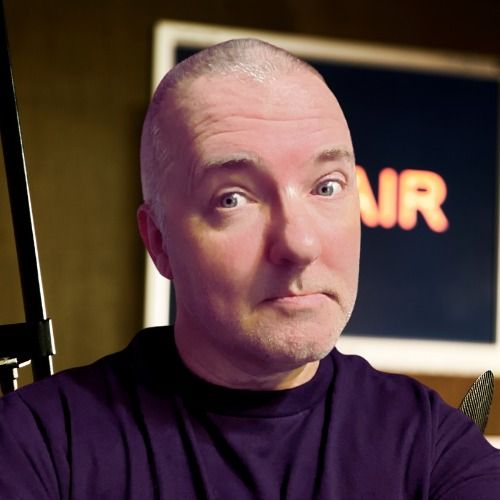Episode 86
Can You Use Processing Effects While Recording Your Podcast Episode?
A question that often pops up is whether you can use processing effects while recording your podcast episode, or should they be added in post-production. So let's dig in.
Products I Use for One Minute Podcast Tips
Note: these contain affiliate links, so I may get a small percentage of any product you buy/use when using my link.
My equipment:
- Shure SM7B dynamic mic
- TZ Audio Stellar X2 condenser mic
- Rodecaster Pro II audio production studio
- Sony MDR-7506 Studio Monitor Headphones
- JOBY Wavo Boom Arm
- Elgato Wave Mic Arm Low Profile
Recommended resources:
Leave a review:
Mentioned in this episode:
Join the One Minute Podders membership for exclusive perks!
You're a serious indie podcaster looking to go beyond the one minute tips offered in each episode. You want to connect with like-minded podcasters as well as ask your own specific questions. Perfect - the One Minute Podders membership is just for you, with invite-only monthly live streams, early access to episodes 48 hours before anyone else, and a link to your podcast in the show notes.
Support One Minute Podcast Tips
Recommend the show
Help your friends and other podcasters discover One Minute Podcast Tips, by sharing/recommending this episode and/or the show with them!
This podcast uses the following third-party services for analysis:
OP3 - https://op3.dev/privacy
Transcript
I'm Danny Brown and you're listening to One Minute Podcast Tips, the show that helps you be a better
Speaker:podcaster in just a minute a week. If you want more specific tips just for you and your podcast,
Speaker:check out the Magic Mic membership at oneminutepodcasttips.com forward slash support.
Speaker:And now, this week's episode.
Speaker:I saw an interesting post over on Reddit the other day that was asking whether you can use
Speaker:processing effects during recording, or if it should all be left to post-production and after
Speaker:recording. So I thought that would make a great topic for an episode of One Minute Podcast Tips.
Speaker:Now, quick disclaimer, this is going to be a slightly longer episode than one minute because
Speaker:I do want to go over a few things with you. And two, I'm not an audio engineer, I'm not an audio
Speaker:expert. It's just my own preferences and what I tend to do and what I've sort of learned over the
Speaker:last few years watching a bunch of videos, etc. regarding editing and post-production, etc.
Speaker:So, to the topic itself. There's pros and cons to doing a lot of processing pre-recording or during recording.
Speaker:The main pro is obviously you've got your voice and everything sounding just like you want it,
Speaker:and you don't have to do a lot of post-processing afterwards, it's mainly editing.
Speaker:However, the main downside to that is, if there's anything wrong with the audio,
Speaker:so let's say you've gone a little bit too crazy with the compression or the noise gate, or anything like that,
Speaker:it's harder to fix that afterwards than it is to fix raw audio that might have some issues on it.
Speaker:So in this episode, I'm just going to give you some examples of what processing sounds like during recording for both condenser and dynamic mics.
Speaker:And it'll give you an idea as to whether you want to use it or not.
Speaker:Now at the moment, I'm using a condenser mic.
Speaker:It's the TZ Audio Stellar X2 large diaphragm condenser.
Speaker:Really nice mic, I like it a lot.
Speaker:I'm running it through my Rodecaster Pro 2.
Speaker:Now the cool thing with the Rodecaster Pro 2 is it has a bunch of presets for you based on what microphone you're using.
Speaker:But it also has a lot of advanced processing that you can do afterwards.
Speaker:So at the moment, I've got zero processing on the condenser.
Speaker:I'm just going to add some basic processing.
Speaker:And this is it with basic processing.
Speaker:What Rode does is add some depth, sparkle, and punch to the recording.
Speaker:And this is just some really basic presets.
Speaker:So the depth one, as the name suggests, adds depth to the vocals.
Speaker:Sparkle is for some more brightness and more detail to your voice.
Speaker:So it helps your voice be a bit clearer.
Speaker:And then punch helps the vocals stay consistent across the recording.
Speaker:So as I mentioned, it's really, really basic processing.
Speaker:Now normally when you're adding processing after a recording
Speaker:There's three or four main ones that you would use
Speaker:So there'd be EQ or equalization,
Speaker:and that helps you manage the frequencies.
Speaker:So if you want a deeper tone, a lighter or a higher tone, etc,
Speaker:you can adjust the frequencies for lows, mids and highs
Speaker:to get to the kind of vocal that you want to come across.
Speaker:There's de-essing which as the name suggests
Speaker:Helps remove s's
Speaker:If your voice is a more sibilant one
Speaker:Where it highlights like the hissing sound on an s
Speaker:Then de-essing can help you with that.
Speaker:You've also got compression
Speaker:and compression reduces the loudest parts while increasing the softest parts of recording, and that
Speaker:helps make it sound clearer louder and more natural without any distortion coming through.
Speaker:You can also use a noise gate, so if your recording environment isn't the best and you've got say a
Speaker:fan in the background or ac or outside noise etc you can use a noise gate. You would then set that
Speaker:noise gate to a level that stops anything above that level coming through and recording - but if
Speaker:you're too aggressive with a noise gate it can actually make the recording worse, because basically
Speaker:what's going to happen is as soon as you stop speaking all the noise that you're knocking out
Speaker:is now going to come charging back in, and it's really distracting. So these are the main ones
Speaker:you would normally use. So as I say I've got basic processing on with the the Rodecaster Pro
Speaker:but what the Rodecaster Pro 2 also has is three other presets. So neutral, podcast studio and
Speaker:broadcast. Neutral, as the name suggests, adds a little bit more advanced processing so it will
Speaker:add some de-esser, EQ, compression etc but not too much. So if I hit the neutral button now
Speaker:and this is me on the neutral - still on the condenser, i'm not changing anything except
Speaker:going through the presets, so this is what the roadcaster pro 2 neutral processing sounds like
Speaker:when running it through the condenser mic setting. I'm now going to go to the podcast studio
Speaker:and this is a podcast studio, you should hear the deeper parts or the lower parts of the recording
Speaker:get a bit more emphasis now and really with the podcast studio it is adding that bit more
Speaker:processing to it, and giving that more polish slightly deeper sound that you'd expect maybe
Speaker:at a recording studio. The last one is broadcast and should be a lot more boomier. So let's do
Speaker:that one now. And this is switched over to broadcast and you should be able to hear a lot
Speaker:deeper, a lot more like the old classic radio recording sounds. So that's a broadcast and let's
Speaker:just go back to the non-processed. So I've taken all the processing off again and I'm back purely
Speaker:on the microphone. So that's what you can do during recording, whether you want to do it or not,
Speaker:It's entirely up to yourself.
Speaker:That's on a condenser mic.
Speaker:Let's switch over to a dynamic mic.
Speaker:So I'm now on the dynamic mic, and this is the Shure SM7B,
Speaker:and I'm running it through the SM7B setting on the Rodecaster Pro 2.
Speaker:There's no other processing on it, just the SM7B setting itself.
Speaker:Processing is completely switched off,
Speaker:so this is exactly what the mic would sound like out of the box.
Speaker:If I switch the processing on,
Speaker:again, it's adding a little bit of the spark, depth, and punch to the vocals
Speaker:that you had on the condenser.
Speaker:You should hear a bit of a difference between condenser and dynamic
Speaker:because with the condenser you don't have to put as much gain through it
Speaker:because you're powering it with 48 volts phantom power.
Speaker:With a dynamic mic you do need more gain so you do have to push it a bit more
Speaker:so you may hear a bit of a difference between the two mics
Speaker:when going through the different settings.
Speaker:But again this is just purely on the SM7B setting
Speaker:with a little bit of depth, sparkle and punch.
Speaker:Now let's go to the SM7B neutral setting.
Speaker:So this is the neutral setting.
Speaker:So again, this is adding a bit more processing.
Speaker:So a bit of de-essing, a bit of high-pass filter,
Speaker:a bit of noise gate and compression and equalizer to the vocals.
Speaker:Not too much because it is still fairly neutral,
Speaker:but it does give you an idea of what the actual effects are.
Speaker:Now I go to Podcast Studio,
Speaker:and this is the Podcast Studio on the SM7B setting.
Speaker:So again, you should start to hear the bass
Speaker:and the lower frequencies being pushed more to the fore,
Speaker:and it cleans up the vocals a little bit more around the mid-range, etc.
Speaker:It's trying to highlight the vocals while giving it a bit more polish and a bit more depth to the tone.
Speaker:And finally, let's go to the Broadcast Studio.
Speaker:And this is the Broadcast Studio preset.
Speaker:Once more, you should hear a lot more boominess, a lot more like grand sound, if you like.
Speaker:Going for that old classic radio vocals of the 70s and 80s for the Broadcast Studio.
Speaker:A lot more processing on this and a lot more effects from the previous examples.
Speaker:But if I go back to knocking the processing off.
Speaker:And this is it back to the SM7B.
Speaker:Purely SM7B out of the box.
Speaker:It is on the SM7B setting on the Rodecaster Pro 2,
Speaker:but I've knocked the processing off.
Speaker:So this is just purely the microphone sound.
Speaker:So that should give you an idea
Speaker:of what the different processing features are
Speaker:and what they bring to the recording.
Speaker:It is entirely up to you
Speaker:whether you add the processing pre-recording
Speaker:and save time editing afterwards,
Speaker:or if you leave everything neutral
Speaker:and then go in afterwards
Speaker:with the post-production editing process
Speaker:and then add your De-Ess, your EQ, your compression,
Speaker:whatever else you want to add to the recording. As I mentioned, there's pros and cons to each.
Speaker:It's really down to you and your recording process and how comfortable you feel recording with
Speaker:processing on versus recording with processing off and having a bit more flexibility afterwards
Speaker:when it comes to repairing the audio. So I hope this has helped in giving you a bit of an idea
Speaker:about using processing pre-recording as opposed to in post-production. Until the next time, happy
Speaker:podcasting. Thanks for listening. If you enjoy One Minute Podcast Tips, be sure to share with
Speaker:your friends and other podcasters so they can enjoy it too. Until the next time, happy podcasting.
Speaker:♪♪♪






